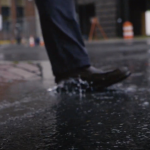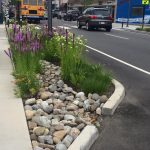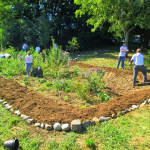New Jersey Future Blog
Stuck with Stormwater Issues? See Expert Solutions to Fight Flooding and Pollution in the Updated Municipal Toolkit
November 10th, 2020 by Andrew Tabas
If your town experiences localized flooding and degradation of nearby waterways due to stormwater runoff, there is a sustainable solution that can help. Green infrastructure (GI) can make your town a healthier, cleaner, and safer place to live by reducing flood risk, returning clean water to the ground, cleaning and cooling the air, and aiding in pedestrian safety.
Not only is green infrastructure a sustainable and effective tool to manage stormwater that all municipalities should implement, the New Jersey Department of Environmental Protection (NJDEP) now requires new public and private major developments to manage stormwater runoff with green infrastructure. This Spring, the NJDEP published the new Stormwater Rules (NJAC 7:8), which take effect March 2, 2021. As the private sector builds more GI to comply with the rule amendments, elected officials and residents will see the resulting increased economic, environmental, and public health benefits.
To achieve the maximum benefit from GI while balancing many priorities, municipal leaders need comprehensive, practical guidance in order to take action. New Jersey Future’s newly updated Green Infrastructure Municipal Toolkit is a one-stop green infrastructure resource designed to help municipal leaders and advocates address the related problems of nuisance flooding and polluted waterways. The new updates will help municipalities leverage the rules to work with developers, understand the effect of the rules, and organize the approval of green infrastructure projects.

The Green Infrastructure Municipal Toolkit, updated in November 2020, contains resources to help municipal leaders to encourage the implementation of green infrastructure.
What Municipal Requirements Do NJDEP’s Stormwater Rules Include?
The key takeaway from the Stormwater Rule amendments for municipal governments is that municipalities are required to update their municipal stormwater control ordinances by March 2, 2021 to comply with the new rules. To assist municipalities with this update, NJDEP has released a model ordinance and indicates that municipalities may go above and beyond the state’s minimum standards to increase the benefits described above. New Jersey Future’s toolkit lists a few ways to do that:
- Reduce the definition of major development so that it applies to smaller projects in order to increase the number of projects that use green infrastructure, which will in turn reduce flood risk across your entire municipality.
- Extend the requirement for green infrastructure to redevelopment projects in order to mitigate the negative effects of stormwater runoff from existing developments.
- Require the retention of at least 1.25 inches over two hours onsite, which eliminates flooding from 90% of New Jersey’s rain events.
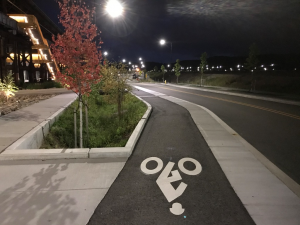
Green infrastructure improves stormwater management and beautifies cities. Photo credit: Andrew Tabas.
Updated ordinances will affect both public and private development projects. For public developments, municipalities will need to collaborate with contractors to ensure that green infrastructure is built according to the best standards. For private developments, the rules provide a pathway for municipalities to work with developers to increase the use of green infrastructure on private land. The toolkit provides resources that are applicable to both public and private projects.
What to Do Next
So, what else can you do to bring the benefits of green infrastructure to your town? Visit the newly updated Municipal Toolkit to check out the following resources.
First, use these checklists to ensure that green infrastructure projects are designed, built, and maintained effectively:
- NJDEP’s “Checklist for Conducting Stormwater Management Reviews.” This checklist presents a straightforward process for municipal boards to approve projects, which makes it easier to ensure that each phase of the project is completed correctly. It includes everything from soil testing to water quality, water quantity, and groundwater recharge requirements.
- Municipal Stormwater BMP Inspections Checklist. This will help municipal engineers to inspect sites during construction. It provides a straightforward way to know which components need to be inspected for each green infrastructure Best Management Practice (BMP).
- Monitoring Logbook. The monitoring logbook will help municipalities to keep track of ongoing monitoring and maintenance activities to ensure GI BMPs are functioning properly.
Second, to get a sense of the improvements that green infrastructure could bring to your municipality, check out these two side-by-side comparisons:
- The Mixed Use Comparison shows the improvements to stormwater management under the updated Stormwater Rule. The example site is able to count infiltration in its stormwater management calculations, which makes it possible to increase the use of bioretention systems while decreasing the size of gray infrastructure. The site also uses a decentralized approach to stormwater management, with green infrastructure distributed throughout the site.
- The Green Streets Comparison demonstrates the benefits of turning a traditional street into a green street. These include improved stormwater management, more beautiful streets, increased accommodation for walkers and cyclists.
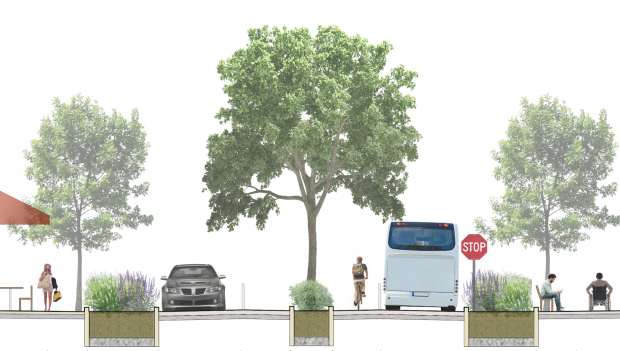
Green streets are pedestrian-friendly alternatives to traditional streets. See the toolkit for a side-by-side comparison of green and traditional streets. Graphic designed by E&LP for NJF.
Third, visit the toolkit’s resources page to check out additional resources that are useful for municipalities, including a maintenance manual, case studies on green streets, and a presentation on harmful algal blooms.
Municipalities have an exciting new opportunity to gain green stormwater upgrades through new development and redevelopment. For more updates, sign up for our mailing list!
The Green Infrastructure Municipal Toolkit is a product of New Jersey Future’s Mainstreaming Green Infrastructure program.
Related Posts
Tags: clean water, GI, green infrastructure, muncipalities, Municipal Toolkit, Stormwater, toolkit

